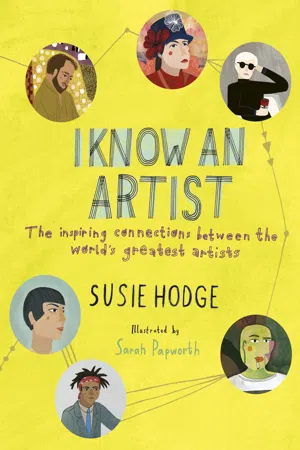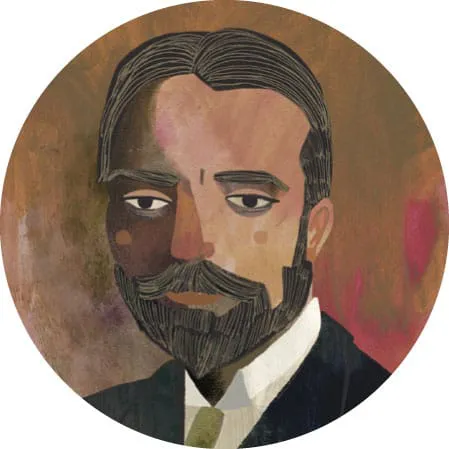ONE OF the founders of Impressionism, Oscar-Claude Monet (1840–1926) remained faithful to the movement’s aims throughout his life: painting en plein air, capturing fleeting moments and using colour to depict the effects of light. Even the name Impressionism came from the title of one of his paintings. As a teenager growing up in Le Havre on the Normandy coast, he began painting outdoors with Eugène Boudin (1824–98). At that time, although some artists made outdoor sketches or visual notes, most paintings were completed in artists’ studios. By painting directly in front of his subject, Monet believed he was capturing light and colour as accurately as possible, and using bright pigments, he rendered everything with bold, broken brushmarks. From 1874 to 1886, he helped to organise, and exhibited in, five of eight independent exhibitions with the artists known as the Impressionists. Although his style changed in later life, he always aimed to capture spontaneous, passing moments, representing the flickering sensations that our eyes naturally see. At first, his sketchy, seemingly unfinished paintings attracted ridicule and derision, but Impressionism later became one of the most significant art movements of the late nineteenth century. Because of his commitment to the movement, Monet’s colourful paintings earned him the epithet ‘the father of Impressionism’.
Throughout his life, Monet produced more than 2,000 paintings and 500 drawings, but initially he faced fierce family opposition. His father wanted him to join the family grocery and ship chandlery business, and his aunt would only support him in his artistic ambitions if he undertook conventional art training. After moving to Paris at the age of nineteen, Monet enrolled at a small studio that disregarded established teaching methods, where he mixed with the avant garde of the day. However, his family cut him off financially and he was often so poor that he could not afford to feed himself, let alone his wife and child. Despite the hostility towards him, Monet persevered. After more than twenty years, he achieved fame and financial success, and in 1883 bought a house in the village of Giverny outside Paris. By 1890, he was wealthy enough to buy a plot of land next to it. There, he employed six gardeners to build a garden and an enormous pond, which was filled with water lilies and spanned by a Japanese-style bridge. For the last thirty years of his life, the artist painted this untiringly in different lights and seasons.
Monet once told a journalist: ‘I perhaps owe it to flowers for having become a painter.’ His paintings of flowers and gardens broke with artistic traditions and generally elevated the status of such themes. He especially liked to paint his own gardens, first at Argenteuil, then at Vétheuil, and finally at Giverny. Similarly inspired by nature, Anya Gallaccio (b.1963) has frequently made flowers a prominent subject. In the same way that Monet broke artistic boundaries with his monumental paintings of lilies, so Gallaccio creates installations consisting of huge expanses of actual flowers, as seen in preserve ‘beauty’ (1991–2003).
Was particularly influenced by the painting Déjeuner sur l’Herbe by
EDOUARD MANET
Helped inspire the painting Carnation, Lily, Lily, Rose by
JOHN SINGER SARGENT
Wrote thousands of letters to friends including
MARY CASSATT
Wrote thousands of letters to friends including
AUGUSTE RODIN
FREQUENTLY INCORPORATING organic material, such as fruit, vegetables and plants, in her work, Anya Gallaccio explores the relentlessness of time and the processes of transformation and decay. Her installations of natural materials change through decomposition during their display period, so they look and smell wonderful at the start, but by the end of an exhibition they are quite the opposite. For example, Red on Green (1992) was a huge rectangle of 10,000 fresh rose heads on a bed of their stalks, left to decompose. Unpredictability is important. She says: ‘I have a notion about a material and about how [it] might react, but I haven’t got a preconceived notion about how it will turn out … You get more experienced about spaces and materials, so you can guess how the material will respond. But I try really hard to have some element where I don’t really know.’
Gallaccio gained international recognition after participating in the ‘Freeze’ exhibition in London in 1988, organised by Damien Hirst (b.1965). The exhibition included the work of sixteen young British artists, most of whom attended Goldsmiths College together, and it elicited the monikers YBAs (Young British Artists) and Britart.
Inspired by a wide range of influences, from Italian fresco painting to the Minimalist works of Donald Judd (1928–94), Gallaccio also uses more traditional sculptural materials, such as bronze. For example, Because I Could Not Stop (2002) is a bronze sculpture of a tree adorned with real apples that were left to rot. Her associations with decay and death form alternatives to the traditional memento mori, which remind viewers of the effects of time on both beauty and life. A professor in the department of visual arts at the University of California in San Diego, Gallaccio was also nominated for the prestigious Turner Prize in 2003 for her work preserve ‘beauty’ (1991–2003), consisting of a wall of gerbera daisies pinned behind a sheet of glass. It evoked notions of still life and landscape paintings, as well as flower arranging and pressing, but gradually, as the flowers decayed, it became something else altogether.
In 2008, Gallaccio was commissioned by the Marquess of Cholmondeley to create the Sybil Hedge at Houghton Hall in Norfolk, based on the signature of his grandmother, Sybil Sassoon. Gallaccio created a sarcophagus-like marble structure at the end of a path, close to a hedge that is planted to follow the shape of Sybil’s signature. In 1907, John Singer Sargent (1856–1925) painted Sybil Sassoon, the Marchioness of Cholmondeley: an elegant aristocrat swathed in a golden shawl.
Was nominated for the Turner Prize, as was
TRACEY EMIN
BRIDGET RILEY
also attended Goldsmiths College in London
AN AMERICAN who spent most of his life in Europe, and an accomplished pianist who often played for his sitters, John Singer Sargent reflected the elegance of the Edwardian era. Like other American artists such as James Abbott McNeill Whistler (1834–1903) and Mary Cassatt (1844–1926), Sargent trained in Paris, from where in 1874 a fellow art student, J...









